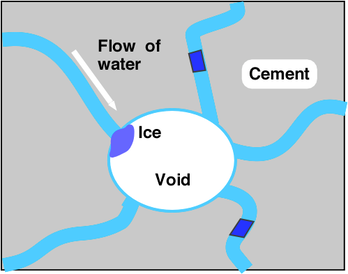
It is widely believed that frost damage results from the volume increase as water changes to ice (as in the wine bottle forgotten in the freezer). If the pores of concrete are nearly saturated, then the volume expansion is an important factor: as ice forms, it displaces unfrozen water that is adjacent to the growing ice crystal, and the frictional resistance to movement of the water creates pressure in the pores that can be destructive. To defend against this, concrete is provided with air voids (by adding surfactants to the water that is mixed with the cement), and the voids act as sinks into which the displaced water can be released without generating high pressure.
When water enters the voids, it freezes and the ice in the void begins to suck water from the surrounding mesopores. The negative pressure in the pore water causes the concrete to contract as it freezes, whereas concrete without air voids expands as ice forms. This phenomenon, first observed by Powers and Helmuth ["Theory of volume changes in hardened Portland-cement paste during freezing", Proc. Highway Res. Board 32 (1953) 285-297], was recently re-examined and quantitatively explained [“Effect of Air Voids on Salt Scaling”, Z. Sun and G.W. Scherer, Cement Concr. Res. 40 (2010) 260–270].
The contraction caused by suction in the pore liquid has two important consequences: (1) it offsets the positive crystallization pressure generated by ice crystals in the small pores (represented by the dark blue objects in the pores in the sketch below), and (2) it offsets the difference in thermal contraction between ice and concrete, which decreases damage from salt scaling.
Quantitative analysis of these phenomena is presented in several of our papers.
